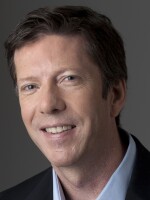AYESHA RASCOE, HOST:
About 23,000 brain scientists gathered in San Diego last week to hear the latest discoveries on how the brain works and how it can be disabled by disease. NPR's Jon Hamilton was there, too, following the science wherever it lead.
JON HAMILTON, BYLINE: So a brain scientist walks into a bar. Actually, in this bar, pretty much everybody is a brain scientist.
Excuse me. I'm looking for neuroscientists. We are....
MATT SZUROMI: I don't know if I technically fall in that category.
EMMA HUELS: We are neuroscientists and...
SZUROMI: I'm an enthusiast.
HUELS: We don't have Ph.D.s yet.
HAMILTON: Don't be fooled. The enthusiast is Matt Szuromi, who works in the lab at the University of Michigan.
SZUROMI: I do dynamical modeling for seizures, epilepsy.
HAMILTON: His friend Emma Huels is also from the University of Michigan.
HUELS: I study the role of different cortical regions in consciousness, using anesthesia and psychedelics and looking at how they change the brain.
HAMILTON: Matt, Emma and the two other scientists at their table have spent the day at Neuroscience 2022, the five-day annual meeting of the Society for Neuroscience. Emma says it's not like the other professional meetings she goes to.
HUELS: There'll be, like, hundreds of people. But in terms of thousands of people that are flooding the streets of San Diego, and you can look around and everybody has some sort of interest in the brain - like, that's very special.
HAMILTON: Two tables over, I find several other brain scientists who are a bit further along in their careers.
NICOLAI URBAN: Hi, I'm Nicolai Urban. I'm the head of the Light Microscopy Core at the Max Planck Florida Institute for Neuroscience.
HAMILTON: A place that helps researchers study even the smallest detail of a brain cell. Urban says this year's meeting is a big deal because COVID-19 prevented in-person events in 2020 and 2021.
URBAN: We tried virtual meetings, but there is just no comparison. There is none of the interpersonal engagement. You don't strike up spontaneous conversations. You don't meet people in the hallways. You don't just, like...
TAMARA MARKOVIC: You don't walk into a bar and see everyone, do you?
HAMILTON: That was Tamara Markovic from Mount Sinai School of Medicine in New York. She studies brain changes associated with drug addiction. This is just one bar in San Diego's Gaslamp Quarter. On this evening, pretty much any place with a good happy hour is teeming with brain scientists from around the world.
The neuroscience meeting is so big that many scientists have to stay at distant hotels and take a bus to the convention center each morning. Some will head off to lectures by the world's leading brain scientists.
(APPLAUSE)
HAMILTON: But the real action takes place in a vast hall where less famous scientists present their work on posters and chat with anyone who shows an interest.
KANATHIP JONGMEKWAMSUK: I am Kanathip Jongmekwamsuk from Thailand.
HAMILTON: From Thailand?
JONGMEKWAMSUK: Yes. Just call me Tan.
HAMILTON: Tan is studying how language processing changes in the brain over a person's lifespan. Not far away is Max Crayen, standing in front of his poster.
MAX CRAYEN: I'm from the German Primate Center in Goettingen, Germany, and it's my first time in the U.S. (laughter).
HAMILTON: And your first SFN meeting.
CRAYEN: Yes, and my first SFN meeting.
HAMILTON: SFN as in Society for Neuroscience. Crayen's poster is about - well, I'll let him tell you.
CRAYEN: Using camera-guided electrode micrograph navigation for precise 3D positioning of electrodes in brain target volumes.
HAMILTON: He's talking about a system that helps scientists record signals coming from an exact location in the brain. It's the kind of technology the brain scientists here are likely to be chatting about later on at one of the local bars.
Jon Hamilton, NPR News, San Diego.
(SOUNDBITE OF MUSIC) Transcript provided by NPR, Copyright NPR.


